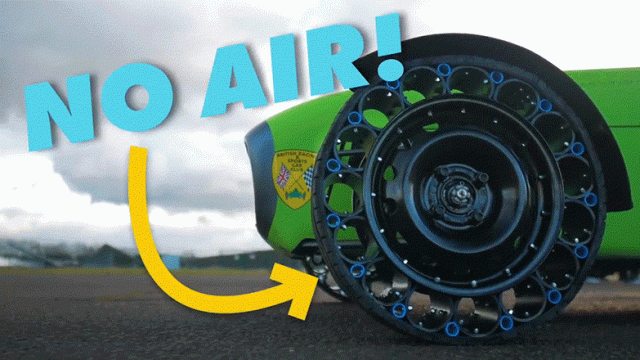Companies like Michelin, Bridgestone, and even Hankook have been demonstrating and promising puncture-proof airless tyres for almost two decades now, but their actual rollout has been limited at best. If you’re tired of waiting, maybe it’s time to just build your own like these brave Brits did using a bunch of PVC piping.
If you’re a driver, there’s good reason to be excited about airless tyres. Cars are expensive and a lot can happen when you’re on the road, but tyres are particularly at risk. You can drop thousands of dollars on a new set and five minutes later have your vehicle rendered unusable after driving over a nail. Airless tyres — as the name implies — aren’t dependent on being filled with pressurised air to function. They instead use a hollow framework of structures made of rubber and other reinforcing materials to provide the same level of cushioning and shock absorption without the risk of ever going flat after a puncture.
But engineering an airless tire that works as well as one filled with air has proven to be quite the challenge. So far they’ve only been made available for smaller vehicles like low-speed ATVs. Michelin’s latest estimate on when its airless tyres will be ready for full-sized vehicles is 2024, at the earliest. Tired of waiting for the tire makers of the world to deem them safe enough for consumers, the YouTube channel Driven Media set out to make their own airless wheels using materials readily available from a hardware store.
To create the signature hollow framework structure of an airless tire, 15 pieces of plastic PVC drain pipe were cut down to size and arranged around a 14-inch steel rim, while smaller pieces of pipe were used to fill in the gaps between the pipes and the outer rubber tread trimmed off a regular tire. The cost for each DIY airless tire was just shy of $US400 ($555), so it’s not necessarily a cheaper approach, but in the long run the risk of punctures or other debilitating damages should be minimised — at least in theory.
Four airless tyres were fitted to a lightweight Caterham car, and while they were a bit louder than the conventional alternative, and random nuts and bolts would come loose while out on the track, the DIY wheels did surprisingly well. They handled pot holes with ease and had no issue rolling across a bed of sharp nails. They even survived hitting speeds of over 161 km/h and successfully drifted for short intervals without completely disintegrating. They didn’t provide the smoothest ride, however, and while nails didn’t result in any permanent damage, another hour out on the roads very well might have. So as hard as it is to be patient, it’s probably a good idea to wait until companies like Michelin officially release their airless tire solutions if you’re gung-ho on making the switch.
